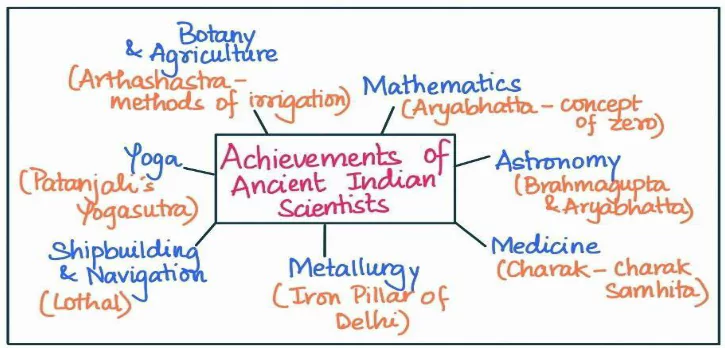Answer:
|
How to approach the question
- Introduction
- Write about Science and technology in ancient India briefly.
- Body
- Write the potential of integrating ancient Indian wisdom to drive contemporary breakthroughs across multiple domains.
- Write the multifaceted achievements of ancient Indian scientists in Science and technology.
- Conclusion
- Give appropriate conclusion in this regard.
|
Introduction
Ancient India made significant contributions to science and technology. The civilization developed sophisticated systems, with notable contributions in mathematics, astronomy, medicine, and
metallurgy. Developments include the concept of zero, Ayurvedic medicine, astronomical observations, and the Iron Pillar of Delhi, illustrating high metallurgical skill.
Body
Potential of integrating ancient Indian wisdom to drive contemporary breakthroughs across multiple domains
- Healthcare: Ayurveda offers insights into personalized healthcare based on individuals’ unique constitutions (doshas). Modern medicine could benefit from this personalized approach, which complements genomics and precision medicine.
- Astronomy and Space Science: Ancient texts, like the ‘Surya Siddhanta’, provide sophisticated models of planetary motions and eclipses. These texts can be further studied to uncover ancient knowledge that might benefit contemporary astronomical studies.
- Materials Science: The metallurgical skills displayed in the Iron Pillar of Delhi and Wootz steel could be further studied to improve corrosion-resistant materials and high-strength alloys in contemporary materials science.
- Mathematics: Ancient mathematical concepts and computational techniques, such as those found in Aryabhata’s works, can be explored to benefit modern mathematical problem-solving and computations.
- Sustainable Architecture: The principles of Vastu Shastra, the ancient Indian science of architecture, advocate harmonious living with nature. These principles could guide the development of sustainable architecture and urban planning in today’s world.
- Mental Health: Mindfulness and meditation techniques derived from ancient Indian practices have already found acceptance in psychotherapy for stress reduction and mental health improvement. There’s potential for further integration.
- Sustainable Agriculture and Ecology: Traditional agricultural practices like organic farming and crop rotation can be integrated with modern farming methods to promote sustainable and eco- friendly agriculture. Example- Incorporation of millets.

Multifaceted achievements of ancient Indian scientists in Science and technology
- Mathematics: The concept of zero, infinity, and the decimal system originated from here. Aryabhata, a notable mathematician-astronomer of the 5th century, introduced the place value system and worked extensively on the approximation of pi.
- Astronomy: For example, Brahmagupta, a 7th-century astronomer, proposed that the earth rotates on its axis. Similarly, Aryabhata accurately defined many astronomical phenomena, like solar and lunar eclipses.
- Medicine: Charaka, a prominent Ayurvedic physician, compiled the ‘Charaka Samhita’, detailing numerous medicinal plants and surgical procedures. Sushruta, often hailed as the ‘father of surgery’, wrote the ‘Sushruta Samhita’ that describes over 300 surgical procedures.
- Metallurgy: The Iron Pillar of Delhi, dating back to 402 CE, stands testament to the advanced corrosion-resistant techniques employed. Similarly, the production of Wootz steel in ancient India was a significant technological achievement.
- Shipbuilding and Navigation: Lothal, a Harappan site, housed the world’s first known dockyard. Indian mariners also developed navigational skills and nautical sciences, which are recorded in texts like the ‘Yuktikalpataru’ by Bhoja.
- Yoga: While not typically classified as a ‘science’ in the Western sense, Yoga is a comprehensive system of health and wellness that integrates physical postures, breath control, and meditation. Patanjali’s ‘Yoga Sutras’ remain influential in modern times.
- Botany and Agriculture: Kautilya (Chanakya): An ancient economist, philosopher, and strategist, Kautilya wrote about agriculture and irrigation methods in his work “Arthashastra.” Ancient Indian texts like the “Rigveda” mention various plants, their uses, and medicinal properties.
Conclusion
In conclusion, ancient Indian wisdom offers a rich repository of knowledge that can be integrated with contemporary science and technology to drive breakthroughs across multiple domains. This integration could lead to sustainable, holistic solutions that address modern challenges.
To get PDF version, Please click on "Print PDF" button.


Latest Comments